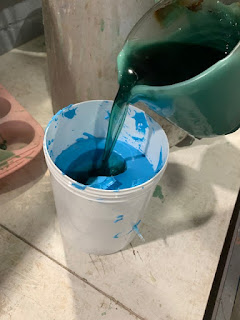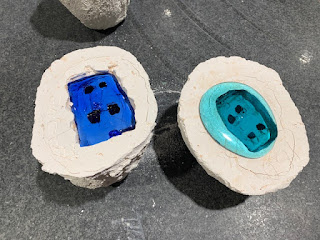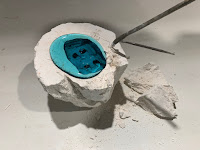We were learning how to use silicon casting material today to take a nice detailed cast of items – which can then be made into wax and finally glass.
The next step was to pour melted wax into the mould, and
wait for that to harden.
Once the wax was set I could
break away the silicon mould – I then set the waxy hand on a lump of clay to
form a base.
Plaster Recipe for refractory mould: (to be measured up as required)
·
1lb plaster powder
·
1lb molochite powder
·
1 pint water
Now it was time to cover the hand
in the plaster mix. Adding layers at a
time to ensure all the parts were covered.
When the mould was dry, it was time to scrape out the clay and melt out the wax.
This was done over a steamer, allowing the wax to drip into a tray which meant it could be reused.
Once the wax was out I have to fill the mould with water to measure how much glass I would need (2.5 x the amount of water)
The mould was then put into
the drying cupboard.
Once dry, I filled a terracotta plant pot with the correct amount of glass and they went into the kiln.
The mould was positioned with a table above made from kiln props, on this sat a plant pot with my measured amount of glass in it. Once the glass melted it dripped through the hole in the plant pot down into the mould.
I used some scrap glass from the HotShop to make this as I fancied a little colour.
Now it was time to very carefully chip away the mould, making sure not to damage the glass inside.
Dah da! A lovely glass hand …. minus a little
pinkie 😊
The silicon mould doesn’t last
long and is not really reusable over time, but I managed to get another wax
cast from it.
This piece didn’t need any
coldworking at all, I purposely underestimated the glass amount needed so I didn’t
have much (or any) overspill, and it all came out quite smooth.























































